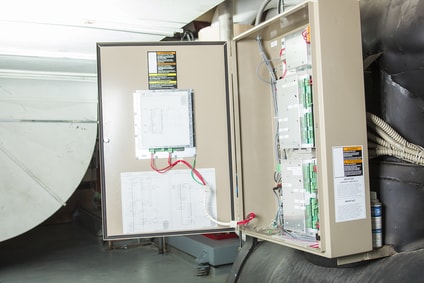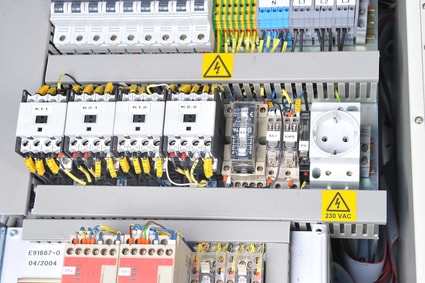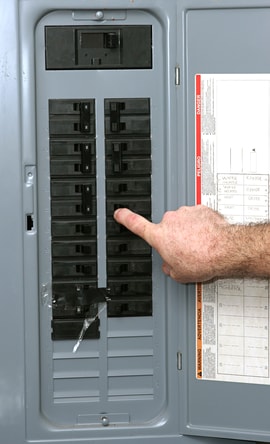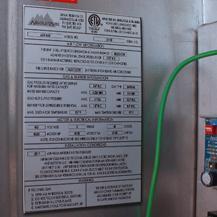Industrial electrical panels are used across numerous industries to direct electric currents among the many pieces of equipment within a facility. Communicating safety and work-related information effectively can mean the difference between a low incident rate and violations or injuries. The Electrical Safety Foundation International (ESFI) has reported that there were over 1,500 electrical workplace injuries in 2018. The best way to prevent workplace injuries is to have a proactive and thorough safety and facilities management program.
This guide will give you a thorough overview of the important considerations for labeling electrical panels and nearby equipment. Labels and tags remain important tools for communicating important information and keeping employees, contractors, and visitors informed. Key topics in the guide include regulatory standards, design considerations, and labeling processes that should be reviewed to identify the optimal way to label and tag your electrical assets.
Included in this guide:

The electrical infrastructure of the average industrial facility is typically complex and runs the span of the entire building. An important function of facilities management is to maintain a high level of awareness for safety and work management at all times. To accomplish this, labels are used in a variety of locations, including electrical panels and associated hardware.
Safety labels are used on electrical panels, connected equipment, and the surrounding areas to warn of potential hazards. These labels typically include a word of warning, symbol, and safety message with a more detailed description. Most of the time, these types of labels are also brightly colored and use red, yellow, and orange colors to attract attention.
Identification labels are also used on electrical panels and wiring to clarify the connections and types of electrical signals that are being used. The components that can be attached to an electrical distribution network may include feeders, disconnects, breaker panels, transfer switches, inverters, and other equipment. Each of these may require labels to identify components, power ratings, and other safety or work-related information.

The labeling and documentation requirements for commercial locations are influenced by local laws, industry regulations, and standardized business procedures. Electrical panels and components in a building must be marked with a number of different labels that highlight both safety and identifying information. Two of the largest regulatory bodies that oversee facilities management in the United States including electrical systems are the Occupational Safety and Health Administration (OSHA) and the American National Standards Institute (ANSI).
Within these guidelines and others, you will find detailed requirements for labeling and documentation that include all aspects of electrical safety and the proper usage of labeling, tags, and signage within facilities. In recent years, OSHA has become more active in conducting inspections and issuing citations for any violations related to electrical labeling and other areas. It is therefore important for all industries to maintain awareness of the requirements and take proactive steps to ensure compliance across their entire electrical infrastructure.
When considering your electrical panels, also remember that there are a number of other electrical components that should also be labeled as part of your plan. These may include:
The best way to remain compliant is to conduct a thorough and frequent review of the relevant regulations and compare them to your local practices.

There are four sets of standards used within the United States that directly address electrical panel labeling in some way. These regulations are monitored and communicated by the Occupational Safety and Health Administration (OSHA), American National Standards Institute (ANSI), National Electrical Code (NEC), and the National Fire Protection Association (NFPA). The following list will highlight some of the important sections within these regulations that are directly related to electrical labels within your facility. This is only an overview, and it is best to consult the regulations in detail to find all the relevant information required for your facility.
OSHA 29 CFR 1910. The Occupational Safety and Health Standards govern every aspect of work environments in the U.S. Within these regulations, a couple of sections are directly relevant to the safety and informational labeling of electrical panels and equipment:
ANSI Z535. While the scope of ISO regulations covers an internationally recognized standard, the ANSI standards have been adopted to specify standards within the U.S. There are thousands of ANSI standards, but the one most important for electrical panel labeling is ANSI Z535 and specifically ANSI Z535.4 American National Standard for Product Safety Signs and Labels.
NFPA 70 / NEC 2020. The NFPA oversees the development of the National Electric Code, and it was recently updated in 2020. These codes serve as the benchmark for electrical hazard management and the design, installation, and inspection of electrical equipment. Since the scope of these guidelines is entirely electrical, it should be a point of focus for review with regard to electrical panel labeling.
NFPA 77 / NFPA 79. In addition to NFPA 70 above that specifically outlines the National Electric Code, these additional resources may be helpful for reviewing your labeling practices as well. This is especially true when reviewing equipment and wiring that will be connected to any electrical panels you are managing.
The design of specific electrical panel labels will depend primarily on regulatory requirements, equipment specifications, durability needs, and materials of construction. Labels must be easy to read from an appropriate distance and be able to withstand the environment. 
When it comes to choosing a specific label, your first decision will be selecting from plastic or metal substrates. As mentioned above, both vinyl labels and polyester labels are good choices when it comes to marking electrical panels and related equipment. They are suitable for most electrical applications and have great durability and readability. Metal labels should be selected for applications requiring robust durability. One of the strongest materials available is Metalphoto photosensitive anodized aluminum, which is used for labels and tags that require a shelf life of over 20 years even in the harshest conditions.
Additional choices to fully customize your label include selecting the size, thickness, and type of adhesive. These should be matched with the needs of your electrical application and any additional requirements. The graphics, colors, and finish can also be customized with a production run to meet the quantity needs of your operation.
Placing your labels on electrical panels, walls, wires, and equipment should be a carefully planned process. It can be easy to miss a required label and be susceptible to a violation during a later inspection. When organizing electrical engineers and facilities maintenance personnel to complete the work, the following label installation best practices may be helpful:
Selecting a proper label for electrical panels in an industrial facility requires a careful look at regulations, your hardware layout, and the environment in which your employees work. Proper planning can support an effective and thorough safety program for your entire operation. In addition to selecting electrical panel labels, your facilities management program should also involve proper maintenance and inspection for your equipment and your labels. Over time labels, may become worn or outdated and require replacement to maintain the integrity of your electrical system.
Further Reading on Electrical Panel Labels:
Our sales engineers are experts in automatic asset tracking, tagging and identification,a nd can answer all your questions. Get in touch now.
Lets Talk ›